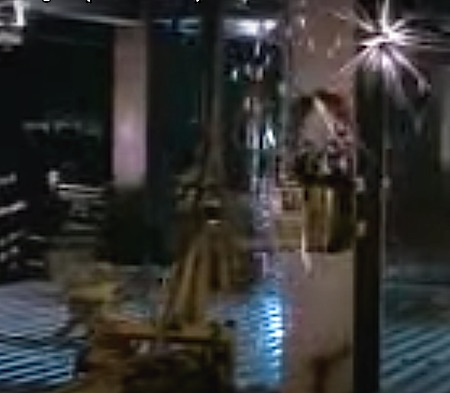Science Fiction
Dictionary
A B C D E F G H I J K L M N O P Q R S T U V W X Y Z
The In Situ Fabricator Construction Robot

Construction robots are starting to evolve into something more interesting; consider the In Situ Fabricator construction robot created by a team lead by Markus Giftthaler at the ETH Zurich in Switzerland:
(The In Situ Fabricator Construction Robot)
The In Situ Fabricator1 is designed from the bottom up to be practical. It can build stuff using a range of tools with a precision of less than five millimeters, it is designed to operate semi-autonomously in a complex changing environment, it can reach the height of a standard wall, and it can fit through ordinary doorways. And it is dust- and waterproof, runs off standard electricity, and has battery backup. On top of all this, it must be Internet-connected so that an architect can make real-time changes to any plans if necessary.To show off its capabilities, Giftthaler and co have used it to build a pair of structures in an experimental construction site in Switzerland called NEST (Next Evolution is Sustainable building Technologies). The first is a double-leaf undulating brick wall that is 6.5 meters long and two meters high and made of 1,600 bricks.
Even positioning such a wall correctly on a construction site is a tricky task. In Situ Fabricator1 does this by comparing the map of the construction site it has gathered from its sensors with the architect’s plans. But even then, it must have the flexibility to allow for unforeseen problems such as uneven terrain or material sagging that changes a structure’s shape.
And lest you think that this robot is really just too slow to be useful, take a look at how robotics has accelerated the fine art of pancake stacking in this real-time video:
We were all introduced to the idea of a construction robot is in the (still excellent!) 1985 movie Runaway.

(Construction robots from Runaway)
Via Technology Review.
Scroll down for more stories in the same category. (Story submitted 1/25/2017)
Follow this kind of news @Technovelgy.| Email | RSS | Blog It | Stumble | del.icio.us | Digg | Reddit |
Would
you like to contribute a story tip?
It's easy:
Get the URL of the story, and the related sf author, and add
it here.
Comment/Join discussion ( 0 )
Related News Stories - (" Robotics ")
Proof Of Robothood - Not A Person
'Who are you people? - Show 'em.' - James Cameron (1984).
Dancing Robots Taught Dance Moves
'A clockwork figure would be the thing for you...' Jerome K. Jerome, 1893.
Factory Humanoid Robots Built By Humanoid Robots
'...haven't you a section of the factory where only robot labor is employed?' - Isaac Asimov (1940).
Mornine Sales Robot
'Robot-salesmen were everywhere, gesturing...' - Philip K Dick, 1954.
Technovelgy (that's tech-novel-gee!) is devoted to the creative science inventions and ideas of sf authors. Look for the Invention Category that interests you, the Glossary, the Invention Timeline, or see what's New.
Science Fiction
Timeline
1600-1899
1900-1939
1940's 1950's
1960's 1970's
1980's 1990's
2000's 2010's
Current News
Google's Nano Banana Pro Presents Handwritten Math Solutions
'...copy was turned out in a charming and entirely feminine handwriting.'
Edible Meat-Like Fungus Like Barbara Hambly's Slunch?
'It was almost unheard of for slunch to spread that fast...'
Sunday Robotics 'Memo
'He then started hand movements of definite pattern...'
Woman Marries Computer, Vonnegut's Dream Comes True
'Men are made of protoplasm... Lasts forever.'
Natural Gait With Prosthetic Connected To Nervous System
'The leg was to function, in a way, as a servo-mechanism operated by Larry’s brain...'
Spidery 'Walk Me' Toyota Autonomous Wheel Chair Like Star Wars
Walk along with the emperor.
Dancing Robots Taught Dance Moves
'A clockwork figure would be the thing for you...'
Proof Of Robothood - Not A Person
'Who are you people? - Show 'em.'
Indonesian Clans Battle
'The observation vehicle was of that peculiar variety used in conveying a large number of people across rough terrain.'
The 'Last Mile' In China Crowded With Delivery Robots
Yes, it's a delivery robot. On wheels.
Tornyol Microdrone Kills Mosquitoes
'The real border was defended by... a swarm of quasi-independent aerostats.'
PLATO Spacecraft, Hunter Of Habitable Planets, Now Ready
'I ... set my automatic astronomical instruments to searching for a habitable planet.'
Factory Humanoid Robots Built By Humanoid Robots
'...haven't you a section of the factory where only robot labor is employed?'
iPhone Air Fulfils Jobs' Promise From 2007 - A Giant Screen!
'... oblongs were all over the floor and surfaces.'
ChatGPT Now Participates in Group Chats
'...the city was their laboratory in human psychology.'
iPhone Pocket All Sold Out!
'A long, strong, slender net...'
